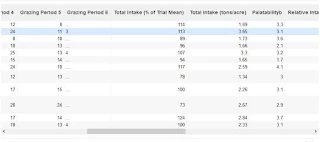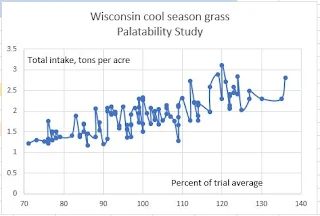New Zealand had been doing it for decades and they were able to make milk, reduce the water content, put it into cans and deliver it to a Walmart shelf in Madison, Wisconsin at lower cost than the dairy farmers around Madison could put the milk into the bucket.
Dairy farmers from New Zealand found many things to criticize about how US Universities did science. Primarily, our tendency to reduce a problem down to what we saw as it component-parts and studying each part in isolation.
As a credit to the University of Wisconsin, they made an effort to address the shortcomings identified by the Kiwis. One criticism was that it does not matter how many tons of hay a grass variety makes if the cows don't eat it. No food through the cow's mouth means no milk in the bucket.
The Wisconsin experiment involved planting a checkerboard of different grass varieties reported as being good for pastures. The checker-board squares represented multiple selections of multiple species. The checkerboards were grazed five times through the growing season or on roughly 4 week intervals.
The standing dry-matter was measured before the cows went in with a weighted pressure plate tool (the standard for the time) and was measured afterward.
The percentage of grass that had been grazed on each checkerboard square was visually estimated when about half the standing dry-matter had been grazed off.
In the report, the raw data was tabulated as well as the percentage of the variety within the trial.
This is when the scientists and the engineers (maybe even the accountants) look at the chart and ask, "Why isn't it a straight line?"
The answer is that the trails were run across multiple sites and across multiple years. Different sites have different types of soil. Different years have different amounts of rainfall. The "Percent of trial average" is an attempt to handicap the cultivar by the year/site space.
The Kiwis
At this point, the Kiwis were smirking like crazy-mad.
Maybe they grudgingly gave a few points for effort but the researchers missed the point. The only two things that mattered were the weight of the milk in the milk bucket and the size of the "slice" needed to provide four hours of mob-grazing.
Since most of the research was done by working farmers, they did mostly A-B experiments which is very inefficient if you want to produce a typical, Land Grant University report. Point being, the farmer's ultimate product was a net profit making milk and the University's ultimate product was a report.
Stung by the criticism, the researchers asked for specifics.
Well, for one thing, the Kiwis pointed out, the correlation between pressure plate measurement and the dry matter not only varies by grass/clover species but by the growth habit of the variety. Some grass has limp, floppy blades, others are rigid and very upright. That is something that individual grazers figure out by experience on their own plots.
You don't just hand a grad student a pressure plate and tell him to write down dry matter.
"Surely, it cannot be that bad." the University scientists dismissed the Kiwis.
 |
| Total intake, tons per acre...is that per annum or were the trails run for different durations? |
Can you, gentle readers, see the two separate populations? The most pernicious fact of this chart is that the worst performing species/cultivar of the most favorable site (for percent trial average) and rainfall is BETTER than the best species/cultivar from the least favorable site/rainfall for Total Intake.
A herdsman who is not minding his Ps and Qs might choose Calibra Perennial Ryegrass over Stampede Orchardgrass based on the research.
That would be an almost disastrous decision if the herdsman's soil was sandy or his region subject to six and eight week periods with no rain.
Where I screwed up
 |
| The second row looked promising. |
My laptop has a small screen. When I scrolled over to the names on the extreme left, I dropped down a row. Simple as that! I
Instead of locking onto the Festulolium that was reported to have produced 3.65 tons per acre I purchased the variety that was reported to produce 1.73 tons per acre.
Why Festulolium? Because it has great seedling vigor, like Perennial Ryegrass, but has better drought and cold resistance. Just the thing for patch repair of damaged pastures.
And in spite of all of that, 1.73 tons per acre is far more than bare dirt, which is what I have where the cattle churned the pasture to a sea of mud.



Ouch... Well, we all live and learn...
ReplyDeleteThat is why, when I would frost-seed my pastures, I would always use at least 3 varieties of grass + red clover + trefoil....-- ken
ReplyDeleteGood plan!
Delete